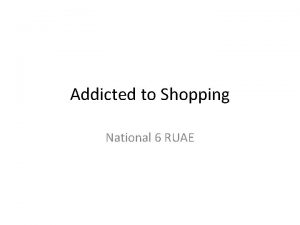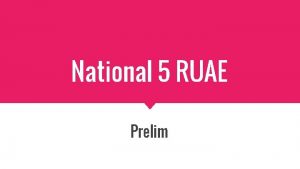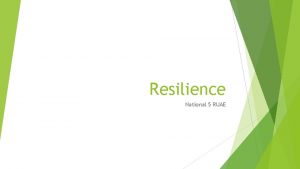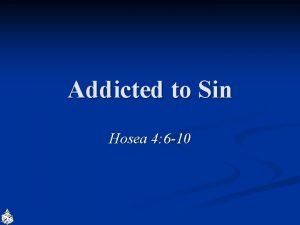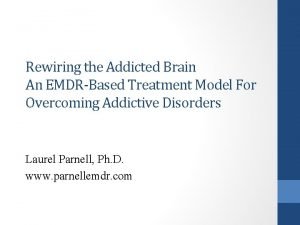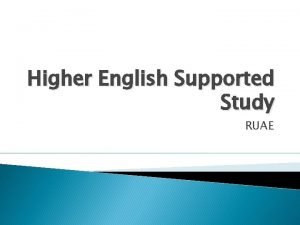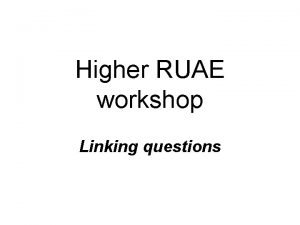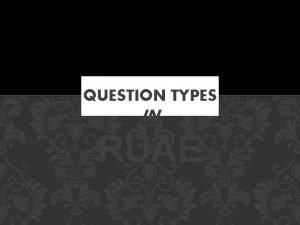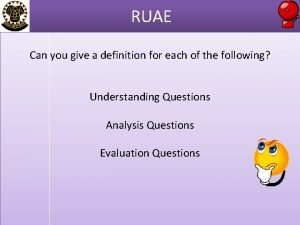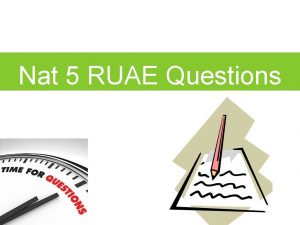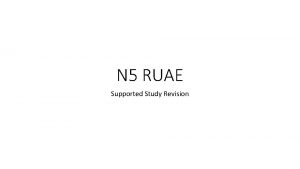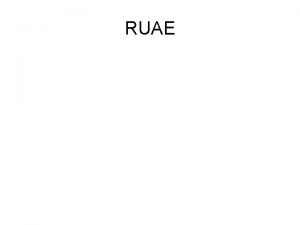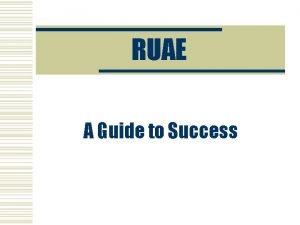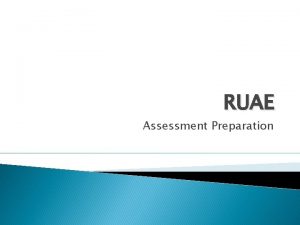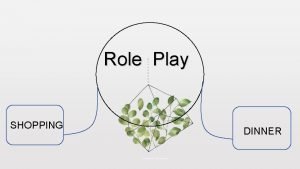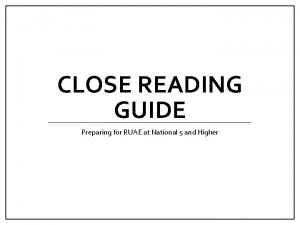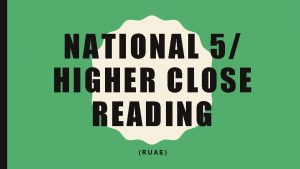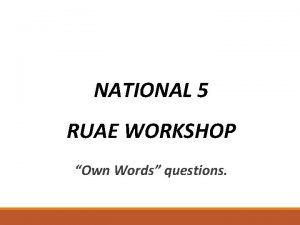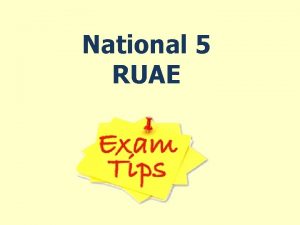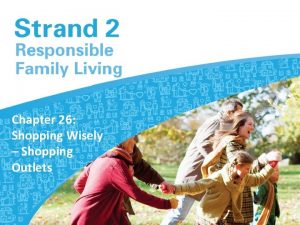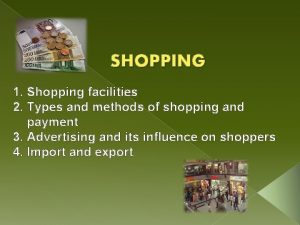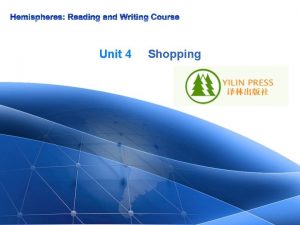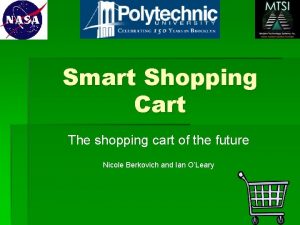Addicted to Shopping National 6 RUAE 1 a




















- Slides: 20

Addicted to Shopping National 6 RUAE

1. a) Candidates should demonstrate understanding of two ways in which malls seem to persuade people to shop more. Candidates must use their own words. No marks are awarded for verbatim quotations from the passage. 1 mark for each point from the additional guidance. Possible answers include: Retailers do not want consumers to sit down and take a break from shopping (“wooden bench purposely designed to be uncomfortable”) Positioning of bench to maximise marketing opportunities (“placed alongside a digital screen”) Use of technology to market products and to tempt consumers (“screen pulsing ever-changing adverts”) The mall offers diverse/seemingly endless methods for consumers to buy

1. b) Candidates should analyse how the language conveys the intensity. Marks will depend on the quality of comment on appropriate language feature. 2 marks may be awarded for reference plus detailed/insightful comment; 1 mark for reference plus more basic comment; 0 marks for reference alone. Possible answers shown in the ―Additional Guidance column. (2)

Word Choice “purposely designed” suggests drive and focus on the part of retailers “pulsing” suggests screen is full of life, constantly moving; a heartbeat which energises consumers “ever-changing” suggests incessant activity on screen, vast number of items on offer “hurrying (in and out)” suggests pressurised, frenetic activity “honouring” suggests that consumers view shopping as a duty to be carried out with devotion “turbo-consumer” suggests the activity of the shoppers is super-charged “live to shop” suggests a fundamental importance, as if a motto of the “creed”; climactic, summative statement

Imagery “shoals” -just a shoal of fish would be a vast quantity of fish, moving collectively and weaving in and out, so the consumers in the mall are shown to be in vast numbers. It suggests that the consumers move in a darting, uniform, unquestioning manner similar to that of a shoal of fish “creed” just as a creed is a set of religious beliefs or principles, so the consumers in the mall place great faith in shopping Sentence Structure List (“other … ways”) emphasises the many options available to consumers Repetition of “other” highlights the many ways in which consumers can spend/ vast range of shopping choices Repetition of “spend” mimics the furious exhortations of retailers/the fast pace of consumer transactions Juxtaposition of repeated options (“other…”) and repetition of a single course of action (“spend”) it could be argued that the juxtaposition of choice and single activity highlights the narrowing focus/determination of consumers as

2. a) Candidates should identify four reasons why the writer suggests consumerism does not make us happy. 2. a) Candidates must use their own words. No marks are awarded for verbatim quotations from the passage. Possible answers include: There will always be new products which we crave (“Every time … better than the one you have. ”) Consumerism acts like an addictive drug (“the heroin of human happiness”) Consumerism can never fulfil our wishes (“… our needs are never satisfied …”) The happiness offered by consumerism is only temporary (“The brief high we feel … “) or (“… just enough to keep us going …”) Consumerism distracts us from what is really important (“… compensation for not having a richer, fuller life. ”) Acceptable reference could be made to aspects of lines 12– 15, e. g. the implications of “treadmill”

2. b) Candidates should analyse how their chosen image emphasises the writer‘s criticism of consumerism. Marks will depend upon the quality of the comment. A detailed/insightful comment will be worth 3 marks; a more basic comment will be worth 1 mark. Mere identification of an image will be 0 marks. When dealing with imagery, answers must show recognition of the literal root of the image and then explore how the writer is extending it figuratively. Possible answers shown in the „Additional Guidance‟ column. )

Turbo-(consumerism)‖: just as a turbo is a supercharger which gives an engine or mechanical system much more power, so the writer suggests that consumerism has become overpowering, having the potential to overwhelm other more meaningful aspects of life voracious appetite‖: just as a voracious appetite describes an insatiable desire to consume food greedily/ravenously, so consumerism encourages an overindulgent approach to shopping seduced‖: to seduce is to tempt an individual, possibly into a sexual liaison or an unwise deed, so the writer suggests that the temptations of consumerism are hard to resist and may corrupt us heroin‖: just as heroin is a highly addictive narcotic, so the writer suggests that we can become dependent on consumerism (brief) high‖: just as a high is a temporary feeling of extreme happiness, so the writer suggests that consumerism offers only fleeting pleasure

3. Candidates should analyse how the writer‘s use of language conveys her disapproval. Marks will depend on the quality of comment. For full marks there must be comment on at least two features. 2 marks may be awarded for reference plus detailed/insightful comment; 1 mark for reference plus more basic comment; 0 marks for reference alone. Possible answers shown in the “Additional Guidance” column.

Sentence Structure List of different types of retail space (―shops …malls‖) emphasises relentless expansion of shopping areas Escalating nature of retail outlets within list (―shops, retail centres, giant malls‖) suggests an evolutionary process/growth which is difficult to stop or inevitable balanced structure/contrast of ―The more… the less…‖ allows the writer to highlight the spiralling negative consequences of increasing retail space balanced structure of ―It may be … but we simply have…‖ creates a dismissive/sceptical tone which allows the writer to highlight that more space devoted to shopping will ultimately deprive us of our liberty Much can be said about ―Kings as consumers, pawns as citizens. ‖ eg: the use of antithesis and/or imagery allows the writer to emphasise and/or summarise the key idea that increased retail opportunities may lead us to believe we have power and control (―kings‖), but the opposite is true: consumerism removes our ability to control our lives and, like ―pawns on a chessboard, we are manipulated by others and have very little power in the game as a whole/society the very basic parallel structure of this final sentence strengthens the antithesis and emphasises the dismissive tone of ―pawns as citizens‖, thereby allowing the writer to highlight her view that we are deluded into thinking we are important when in fact basic rights of citizenship are

Word Choice giant suggests that malls are an overwhelming or frightening presence taking over has connotations of conquest/invasion, suggests retail space is a hostile force winning a war Worldwide - suggests global domination Mainstream associates the vast amount of retail space with the humdrum, mediocre, unadventurous � Monoculture - just as a monoculture is a crop of a single species, often grown in vast fields, so the enormous amount of shopping space lacks variety and restricts the growth of other activities which we could pursue Footfall - suggests that so much retail space depersonalises us/ shoppers become mere statistics grazing time- suggests that exposure to more retail space has lessened our ability to think for ourselves: we become like animals, following the herd/latest trend (retail) creep - to creep is to move forward stealthily, possibly with the intention of causing harm, suggesting that the growth of shopping space has been insidious and may be harmful to society � there‘s not much else to do but shop - creates a despairing/frustrated tone by using basic vocabulary in a matter-of-fact statement citizens…make decisions…equally and collectively… world rather elevated language suggests that increased shopping space removes our higher values, leaving us intellectually poorer and deprived of our basic rights � diminished - suggests reductive properties of increasing retail space simply suggests we will be left with something basic, lacking value if we devote more space to shopping

4. Candidates should be able to reflect on how successfully this description downplays the writer‘s own fears. Candidates could argue that the description does or does not help to downplay her concerns. 2 mark for each point from the additional guidance (1 additional comes from concept of question) (3)

teeming with shoppers despite the credit crunch suggests it‘s not a problem, because so many are still shopping and benefiting the economy (even in financially strained times) people don‘t look … disempowered suggests it‘s not a problem, because these shoppers still have the right to make their own decisions �― people don‘t look … depressed suggests it‘s not a problem, because the shoppers do not appear to be unhappy purposeful - suggests it‘s not a problem, because the shoppers are clearsighted in their aims teeming with shoppers despite the credit crunch - suggests it is a problem, because large numbers are shopping even though they can ill afford to Use of qualifying adverb ―particularly before ―disempowered or depressed‖ suggests that the writer cannot be whole-heartedly positive in her description of the shoppers I suppose suggests a reluctance on the writer‘s part to see consumers in a positive light ―strangely distracted … magnetic shop signs - suggests it is a problem, because the shoppers are not in control of their own actions, are in an almost hypnotic state or any other acceptable answer.

Candidates should demonstrate a sound understanding of how ‗evolutionary psychology‘ explains our desire to shop. Candidates must use their own words. No marks are awarded for verbatim quotations from the passage. A developed answer should score 2 marks; a less well-developed answer 1 mark. Candidates should identify two reasons why the argument relating to evolution is not correct. Candidates must use their own words. No marks are awarded for verbatim quotations from the passage. 1 mark for each point from the additional guidance. (4)

A developed response might be: �We think our outward appearance, as represented by a display of material goods, has become the means by which we can indicate our suitability as a mate. or any other acceptable answer. �Most people are not aware of or concerned with what other people wear (ie acceptable gloss of ―the vast majority of people …wearing‖ and/or ―The fundamental consumerist delusion …‖) It is people‘s ability to express themselves, to display lively intelligence, to express love which matters (ie gloss of ―their conversation, their wit, or their affection‖)

6. Candidates should evaluate the final paragraph‘s effectiveness as a conclusion to the passage as a whole. Marks will depend on the quality of comment. For full marks there must be appropriate attention to the idea of a conclusion. A more basic comment may be awarded 1 mark. Possible answers shown in the “Additional Guidance” column.

The following points could be made, but all points which candidates propose will have to be judged on their merits: �The attitude and behaviour of the ―two young shoppers‖ are the embodiment of ―modern consumerism‖ as mentioned in the opening sentence; they follow the creed of ―live to shop‖, illustrating the idea behind the title �The ―two young shoppers‖, as a device, allow the writer to return to the physical setting of the mall which is used at the beginning, in the middle and at the end, illustrating the scale of the shopping phenomenon �The ―two young shoppers provide a circular structure to the passage because the writer introduces ―a young woman‖ near the beginning who is also laden with her purchases and engaged ―in turbo-consumerism

7. Candidates should identify key areas of disagreement in the two passages by referring in detail to both passages. There may be some overlap among the areas of agreement. Markers will have to judge the extent to which a candidate has covered two points or one. Candidates can use bullet points in this final question, or write a number of linked statements. Evidence from the passage may include quotations, but these should be supported by explanations. Approach to marking shown in the “Additional Guidance” column. Key areas of disagreement shown in grid below. Other answers are possible.

�The mark for this question should reflect the quality of response in two areas: �identification of the key areas of agreement in attitude/ideas �level of detail given in support �The following guidelines should be used: �Five marks — comprehensive identification of three or more key areas of disagreement with full use of supporting evidence �Four marks — clear identification of three or more key areas of disagreement with relevant use of supporting evidence �Three marks — identification of three or more key areas of disagreement with supporting evidence �Two marks — identification of two key areas of disagreement with supporting evidence �One mark — identification of one key area of disagreement with little evidence. Zero marks — failure to identify any key area of disagreement and/or total misunderstanding of task and no supporting

Antithesis is used in writing or speech either as a proposition that contrasts with or reverses some previously mentioned proposition, or when two opposites are introduced together for contrasting effect
 Addicted to shopping ruae
Addicted to shopping ruae How to answer imagery questions national 5
How to answer imagery questions national 5 In your own words questions national 5
In your own words questions national 5 Effective conclusion higher english ruae
Effective conclusion higher english ruae Is addiction a sin
Is addiction a sin Rewiring the addicted brain
Rewiring the addicted brain How to answer close reading questions
How to answer close reading questions Ruae techniques
Ruae techniques Language questions ruae
Language questions ruae Higher english ruae
Higher english ruae Linking questions higher english
Linking questions higher english Ruae
Ruae Ruae question types
Ruae question types Ruae
Ruae Ruae higher english
Ruae higher english Types of sentence structure higher english
Types of sentence structure higher english How to answer ruae questions nat 5
How to answer ruae questions nat 5 Ruae revision
Ruae revision Antithesis sentence structure
Antithesis sentence structure English ruae higher
English ruae higher Ruae tips
Ruae tips
